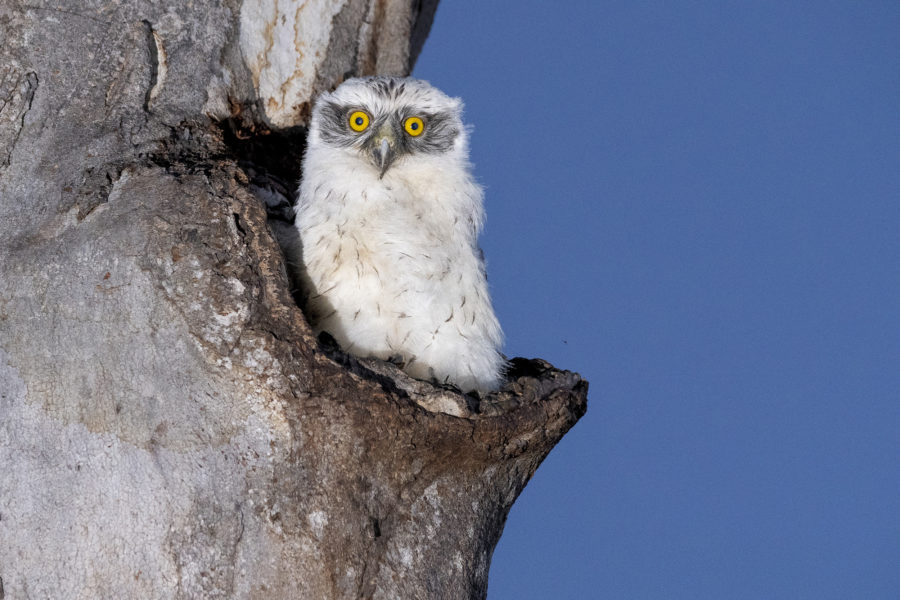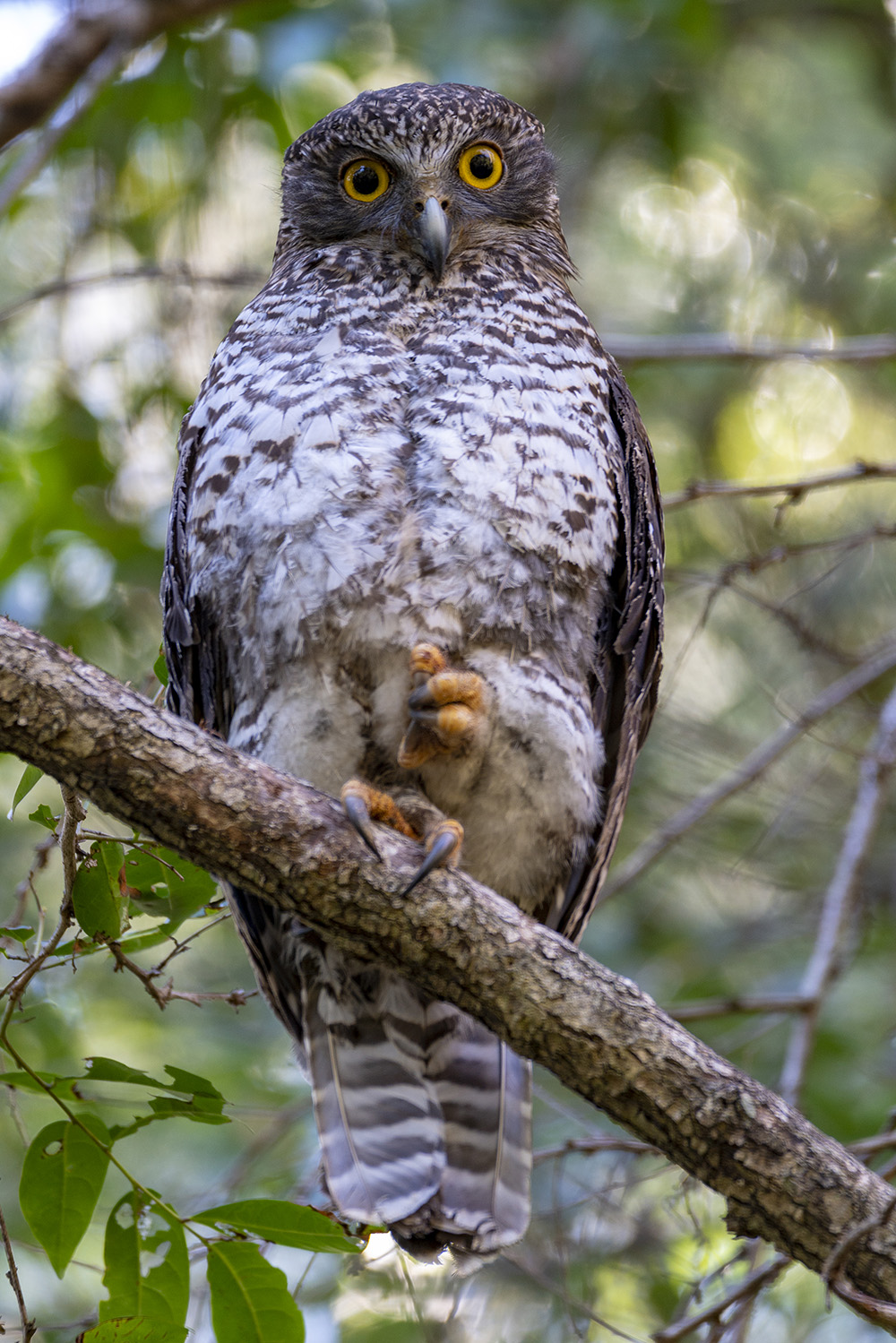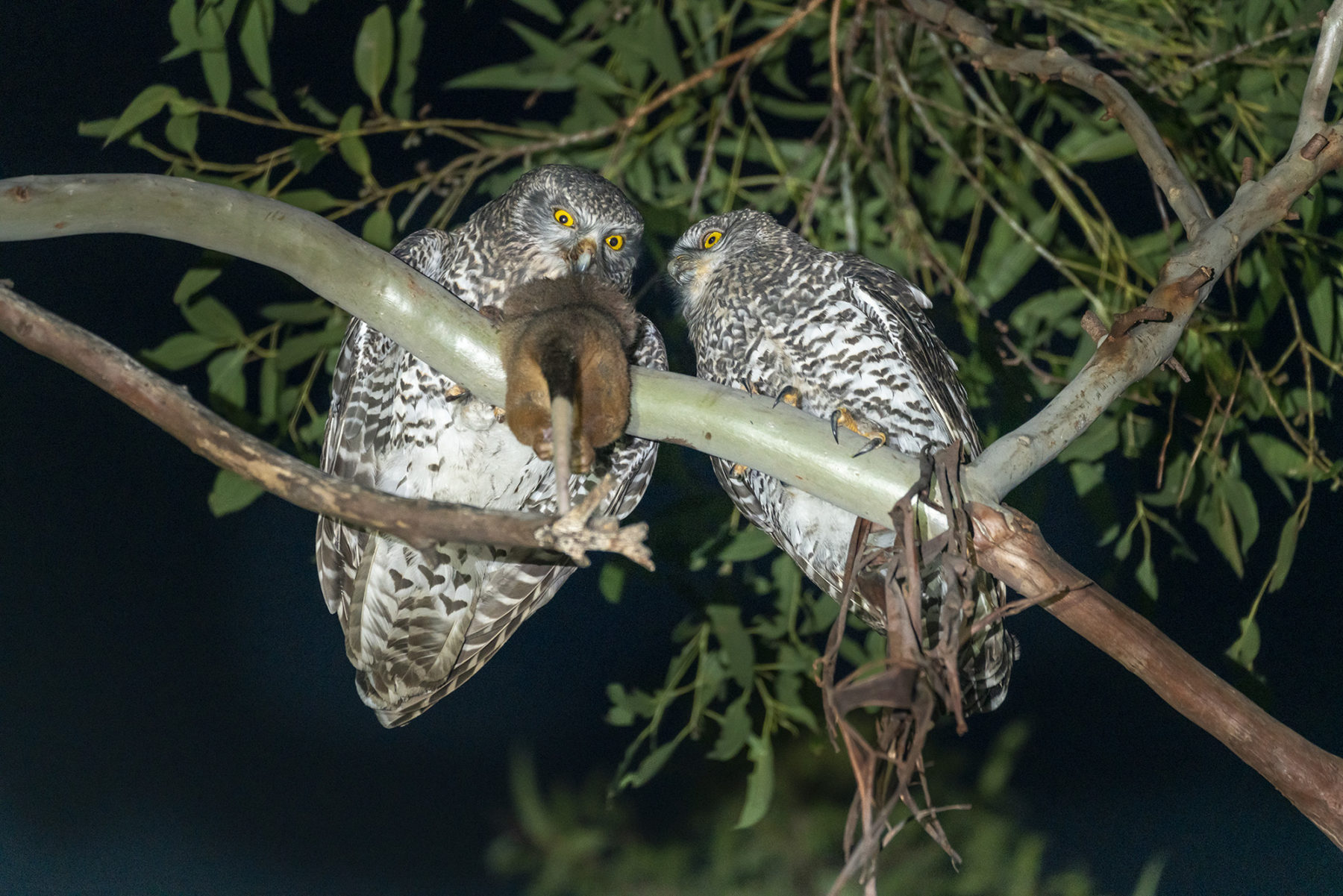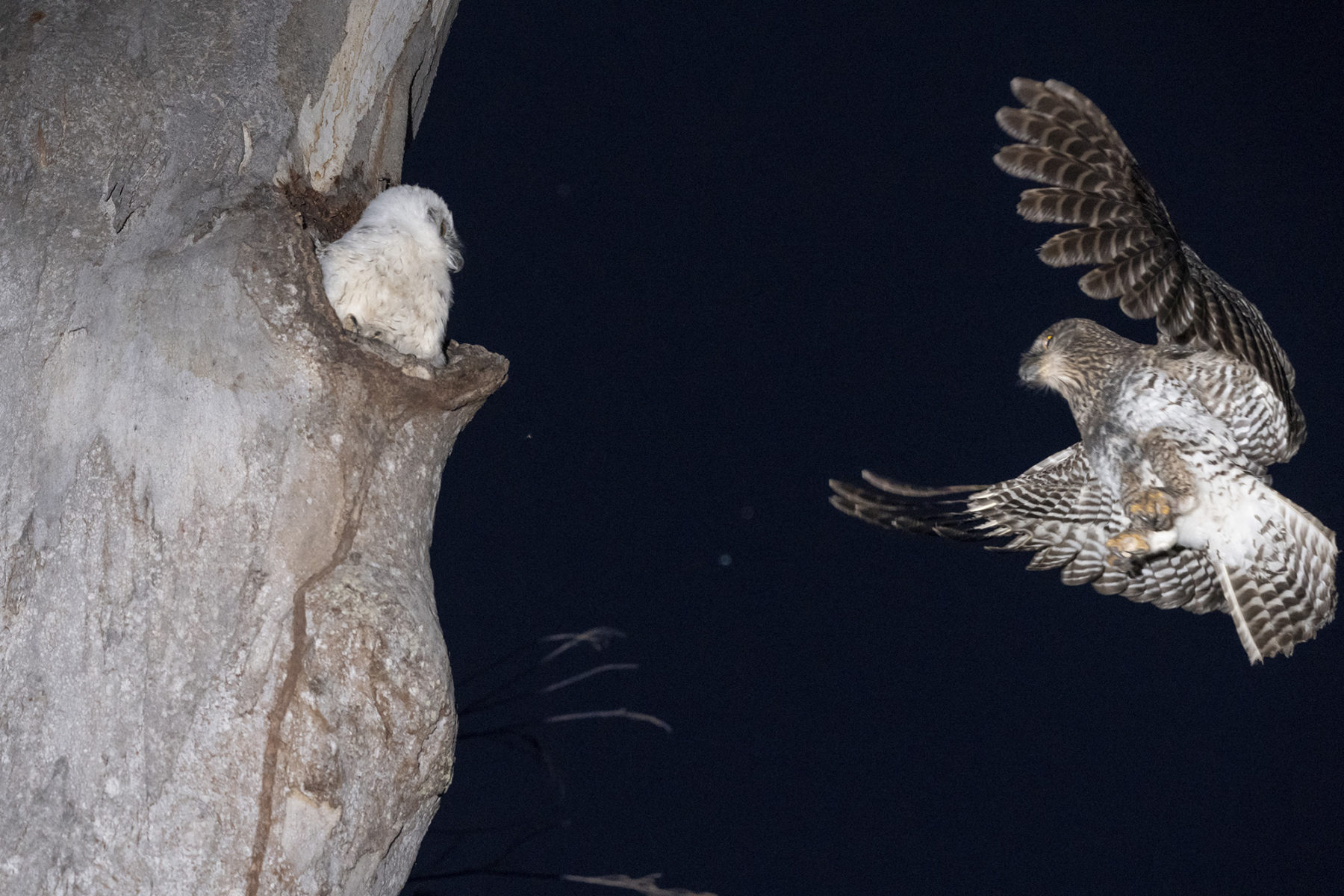Powerful owls: the reason to protect remnant bushland in our cities

HUDDLED BESIDE OUR backyard fire on a moonless winter night, my wife, Marcelle, and I were lulled by sounds of growling possums, trickling water and crackling flames. “Did you hear that?” Marcelle asked as she sat up suddenly. “A high-pitched trilling, like a baby calling its mother.”
We’d just moved into a new home on Sydney’s northern beaches and had no idea this strange noise was to become such a familiar and welcome part of our lives. Our cottage is one of the area’s original residences and, as we soon happily discovered, our backyard is shared territory with a menagerie of native wildlife.
It abuts a littoral rainforest patch through which a spring-fed creek flows before tumbling into a glittering waterfall. This gully of tall, spotted gums, spiky cabbage palms and towering tree ferns attracts birds and supports many small mammals and reptiles.
The first night in the house I was woken at dawn by a cacophony of squawking birds. Opening the back door to investigate, I saw a male powerful owl (Ninox strenua) clutching a brushtail possum in a tree. As a squadron of birds harangued him like harpies, he shot me a glance, unfurled his wide wings and launched from his perch, the dead possum dangling from his huge talons.
A few nights later we realised the mysterious trilling was coming from a tree surrounded by dense bush. Then one evening, as we sat beside our fire, the sound began moving towards us. A large, downy, white powerful owlet settled on a branch above our heads, big yellow eyes peering from its rhythmically bobbing head. Next morning, it was roosting with its parents in giant bamboo near our back door.

Taking a break from raising her nestling, our resident mother owl, with brood patch on her belly, clenches her talons in a signal to potential threats to stay away. (Image credit: Andrew Gregory)
Science citizens
The powerful owl is the largest of Australia’s 11 owl species. Endemic to the mainland’s east and south-east, it’s listed as a threatened species throughout its range. BirdLife Australia’s Birds in Backyards program co-manages the Powerful Owl Project (POP), which is using public sightings recorded on its Birdata app to build a detailed picture of the distribution and breeding success of the species across the Sydney Basin.
The undulating topography of the NSW capital underpins a mosaic of meandering bushland remnants in an urban matrix. These green fingers of native vegetation, which mostly follow gullies or creeks, are animal highways in urban landscapes and increasingly important powerful owl habitat.
Bush within them can have tree canopies suitable for roosting and dense undergrowth. These also support prey such as ringtail and brushtail possums and often have suitable nesting sites.
So far, POP has recorded about 230 owl territories near creeks. The owls nest in hollows that are in short supply because they’re only found in large, old trees, typically taking 150-plus years to develop. Often, a breeding pair will use the same nest hollow year after year.
Soon after our first owlet encounter, POP officer Dr Beth Mott came to our house to show us signs in our backyard indicating the presence of powerful owls – “POs” she calls them. At the base of a cheese tree she found ringtail possum teeth in grey, finger-long pellets containing fur and bone.
“These are like a cat’s fur ball,” she said. “They tell you what an owl has been eating.” Around the tree’s base Beth showed us what looked like dried yoghurt splashes of uric acid paste known as ‘whitewash’ that indicate owl perching and roosting trees. “I spend a lot of my time looking for poo and vomit,” Beth said, laughing.
We headed for the nest tree – a spotted gum with a hollow about 7m up. A whitewash patch indicated where the male had been roosting. Sadly, we found an owlet’s remains at the tree’s base.
As she took samples Beth explained that the chick was unlikely to have fallen from the nest but had probably been eaten by its parents – a supreme act of recycling. She showed how the feathers were spread out. “See how cleanly they’ve been cut?” Beth said. “I’ve only seen this once before.”
Fledgling mortality is relatively high. Research suggests that in 2017 alone, a tenth of the Sydney Basin’s PO owlets died within a week of fledging.

Bringing up baby
The PO family remained in our backyard, hiding in the tree canopy and growling at noisy miners and currawongs that squawked at them whenever they moved. Sometimes, the adult owls roosted all day with a kill before feeding strips of flesh to their owlet in the evening, responding to its shrill trilling as it begged for more. Ringtail possum was the most common menu item, but we also saw them feeding on brushtails, flying foxes and young brush turkeys and other birds.
At dusk, they would begin calling to each other. Then the parents would fly off to hunt, leaving the owlet, which we named Snowy, alone. If we turned on our lights, Snowy would come to the tree above our back door and trill. When Marcelle called its name, it would reply, trilling and head bobbing as it moved from tree to tree. When we had fires, it would often come down and catch beetles attracted to the light.
Snowy slowly shed its downy chest feathers as its adult plumage appeared. Males have square heads, while females’ heads are rounder; Snowy looked to be a male. He stayed around all summer, suffering on hot days and coming down to the creek to drink. In the evenings he practised hunting, scaring bats and trying to catch rats and small birds.
We listened as Snowy’s voice broke over the course of a week before he began calling like an adult, with one long, shaky “wooo”. Then suddenly he was gone.
Tragically, we discovered he’d been killed by a car in our street and was buried in a neighbour’s backyard. Collisions are one of the biggest threats to POs. Research indicates car strikes kill 17 per cent of the entire population every year and cause more than 80 per cent of PO deaths near Sydney. Owls are also killed when they fly into windows.
The parents roosted in the same tree for days at a time. I was struck by how cat-like they were, growling, purring and grooming each other. POs mate for life and these two were clearly love birds.
In the lead-up to the winter breeding season following Snowy’s death they were obviously still together and resident in our backyard. We heard them courting one day at dusk, making deep growls and purrs to each other, before eventually mating.
By June, the female was ensconced within the tree and clearly nesting. The male would call to her and she would answer. Powerful owl eggs are hen’s-egg size and incubation takes about 38 days.
We had gained their trust and they apparently recognised us by sight, so we could watch them near the hollow. In late August, the female began to leave the tree. The male continued to bring food for her and the owlet, which we could hear trilling from inside the hollow. After hatching, powerful owlets grow rapidly, taking 30–35 days to become 55cm fledglings.
By then, I had become a volunteer with the Powerful Owl Project. One day, Beth called and asked me to check if there were any POs in a nearby reserve where the council was planning a fuel-reduction burn.
Controlled burns are often held at crucial times when owls and other fauna breed. When owls are choosing a nesting hollow, they’re easily spooked, and clearing vegetation or burning near a nest tree can cause owls to abandon a long-held nest site. Even just the smoke from a fire can be a problem; when valleys fill up with smoke, both young and adult owls can die.
I visited the reserve and slowly walked through the forest, scanning the canopy. While peering up at the opening of a large hollow in an ancient dead tree, I stepped on a branch. The noise startled a resident owlet, which popped its head out and peered down at me. I passed the sighting on to Beth, who alerted the council and the burn was cancelled. The owlet and its sibling successfully fledged about a week apart.

Part of the family
In our second nesting season our resident owl pair again produced a single owlet – Snowy II, a female who also often perched in the tree above our back door. At night, we’d listen to her hassling her mum for food outside our bedroom window.
Research suggests that as habitat becomes scarcer, young owls are staying longer with their parents, who will continue feeding them into the next breeding season and that appeared to happen with Snowy II.
What makes our backyard ideal is that it has a breeding hollow, access to water, somewhere safe to roost and enough prey to support breeding. But suburban Sydney has a limited number of locations that tick all those boxes.
Two powerful owls wash their eyes in the author’s bird bath.
The total adult PO population in the Sydney Basin is thought to now be about 500, which is probably at about capacity, with nesting habitat availability likely to be the limiting factor.
Urban development is making suitable habitat ever scarcer. We feel privileged to share our home with our owl residents and are working hard to optimise the habitat for them; visitors are often surprised at the diversity of flora and fauna in our backyard.
The owls are now an integral part of our lives – I talk to them while working in my vegetable patch and I lie awake at dawn, listening for the calls that tell me they are returning home from foraging.
Author Andrew Gregory recounts his experience in his backyard
This article was originally published in Issue 154 of Australian Geographic.


